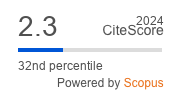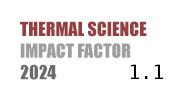ABSTRACT
In this study, the effects of varying pre-injection rates (10%, 20%, 30%, 40%) on engine performance, combustion efficiency, and emissions were investigated in a partial premixed compression ignition (PPCI) engine using JP8 fuel at various loads (0%, 25%, 50%, 75%, and 100%) and compared with diesel fuel. A 10% pre-injection rate was most effective in maintaining fuel efficiency across loads, showing the lowest BSFC values. At 50% load, the 10% rate resulted in a brake specific fuel consumption of 294.22 g/kWh, only 9.69% higher than diesel. Higher rates (30% and 40%) increased fuel consumption and decreased efficiency. Combustion efficiency and CO2 emissions improved with 20% and 30% rates, especially at high loads. At 75% load, 30% pre-injection increased CO2 emissions to 8.827%, exceeding diesel 7.88%, indicating better combustion. Soot emissions decreased significantly with 30% and 40% rates, but NOx emissions rose substantially, with the 40% rate reaching 1448 ppm at full load. The 10% rate was deemed optimal for balancing efficiency and low emissions, while higher rates, though beneficial for combustion and soot, require measures to mitigate NOx emissions.
KEYWORDS
PAPER SUBMITTED: 2024-12-20
PAPER REVISED: 2025-02-15
PAPER ACCEPTED: 2025-04-04
PUBLISHED ONLINE: 2025-09-26
THERMAL SCIENCE YEAR
2025, VOLUME
29, ISSUE
Issue 4, PAGES [3001 - 3011]
- Benajes. J., et al., Effects of Direct Injection Timing and Blending Ratio on RCCI Combustion with Different Low Reactivity Fuels, Energy Conversion and Management, 99 (2015), July, pp. 193-209
- Reitz, R. D., Duraisamy, G., Review of High Efficiency and Clean Reactivity Controlled Compression Ignition (RCCI) Combustion in Internal Combustion Engines, Progress in Energy and Combustion Science, 46 (2015), Feb., pp. 12-71
- Durmusoglu, S., Kosa, E., An Experimental Comparison of the Effects of Jet Fuel (F-34) and Diesel (F-54) on the Wear of Fuel System Components and Fuel Consumption of an Internal Combustion Diesel Engine, Transactions of the Canadian Society for Mechanical Engineering, 46 (2022), 1, pp. 50-58
- Belcher, O., et al., Hidden Carbon Costs of the "Everywhere War": Logistics, Geopolitical Ecology, and the Carbon Boot-Print of the US Military, Transactions of the Institute of British Geographers, 45 (2020), 1, pp. 65-80
- Spudić, R., et al., Single Fuel Concept for Croatian Army Ground Vehicles, Promet - Traffic & Transportation, 20 (2008), 3, pp. 181-187
- Lu, Y., et al., Research on the Application of Aviation Kerosene in a Direct Injection Rotary Engine-Part 1: Fundamental Spray Characteristics and Optimized Injection Strategies, Energy Convers. Manag., 195 (2019), Sept., pp. 519-532
- Yang, W., et al., Impact of Various Factors on the Performance and Emissions of Diesel Engine Fueled by Kerosene and Its Blend with Diesel, Energy Procedia, 142 (2017), Dec., pp. 1564-1569
- Oszczypała, M., et al., Analysis of Light Utility Vehicle Readiness in Military Transportation Systems Using Markov and Semi-Markov Processes, Energies, 15 (2022), 14, 15145062
- Zha, K., et al., Investigation of Low-Temperature Combustion in an Optical Engine Fueled with Low Cetane Sasol JP-8 Fuel Using OH-PLIF and HCHO Chemiluminescence Imaging, SAE Technical Papers, 2013-01-0898, 2013
- Ickes, A. M., et al., Effect of Fuel Cetane Number on a Premixed Diesel Combustion Mode, International Journal of Engine Research, 10 (2009), 4, 3809
- Park, Y., et al., Application of Jet Propellant-8 to Premixed Charge Ignition Combustion in a Single-Cylinder Diesel Engine, International Journal of Engine Research, 16 (2014), 1, pp. 92-103
- Lee, J., Bae, C., Application of JP-8 in a Heavy Duty Diesel Engine, Fuel, 90 (2011), 5, pp. 1762-1770
- Appeldoorn, J. K., Dukek, W. G., Lubricity of Jet Fuels, SAE Technical Papers, 660712, 1966
- Kaminski, P., Experimental Investigation into the Effects of Fuel Dilution on the Change in Chemical Properties of Lubricating Oil Used in Fuel Injection Pump of Pielstick PA4 V185 Marine Diesel Engine, Lubricants, 10 (2022), 7, 10070162
- El Shenawy, E. A., et al., Comparative Study of the Combustion, Performance, and Emission Characteristics of a Direct Injection Diesel Engine with a Partially Premixed Lean Charge Compression Ignition Diesel Engines, Fuel, 249 (2019), Aug., pp. 277-285
- Cheng, X., et al., Investigation into Partially Premixed Combustion Fueled with N-Butanol-Diesel Blends, Renew. Energy, 86 (2016), Feb., pp. 723-732
- Rezaei, S. Z., et al., Investigation of Two-Stage Split-Injection Strategies for a Dieseline Fuelled PPCI Engine, Fuel, 107 (2013), May, pp. 299-308
- Yu, L., et al., An Experimental Investigation on Thermal Efficiency of a Compression Ignition Engine Fueled with Five Gasoline-Like Fuels, Fuel, 207 (2017), Nov., pp. 56-63
- Kim, M. Y., et al., Combustion Characteristics and NOx Emissions of a Dimethyl-Ether-Fueled Premixed Charge Compression Ignition Engine, Energy and Fuels, 22 (2008), 6, pp. 4206-4212
- Tang, Q., et al., Experimental Study on the Effects of Spray-Wall Interaction on Partially Premixed Combustion and Engine Emissions, Energy and Fuels, 33 (2019), 6, pp. 5673-5681
- Kim, H., et al., Effect of the Atkinson Cycle Combined with Calibration Factors on a Two-Stage Injection-Type Premixed Charge Compression Ignition Engine, Energy and Fuels, 23 (2009), 10, pp. 4908-4916
- Singh, A. P., et al., Fuel-Injection Strategy for PCCI Engine Fueled by Mineral Diesel and Biodiesel Blends. Energy and Fuels, 31 (2017), 8, pp. 8594-8607
- Benajes, J., et al. Partially Premixed Combustion in a Diesel Engine Induced by a Pilot Injection at the Low-pressure Top Dead Center, Energy and Fuels, 23 (2009), 6, pp. 2891-2902
- Yamık, H., et al. Effect of Aviation Fuel Jp-8 and Diesel Blends on Performance and Exhaust Emissions in a Single Cylinder Diesel Engine, Gazi University Faculty of Engineering and Architecture Journal, 28 (2014), 4, pp. 787-793
- Lee, J., Bae, C., Application of JP-8 in a Heavy Duty Diesel Engine, Fuel, 90 (2011), 5, pp. 1762-1770
- Szymkowicz, P. G., Benajes, J., Development of a Diesel Surrogate Fuel Library, Fuel, 222 (2018), June, pp. 21-34
- Han, M., The Effects of Synthetically Designed Diesel Fuel Properties - Cetane Number, Aromatic Content, Distillation Temperature, on Low-Temperature Diesel Combustion, Fuel, 109 (2013), July, pp. 512-519
- Chen, H., et al., Investigation on Combustion and Emission Performance of a Common Rail Diesel Engine Fueled with Diesel/Biodiesel/Polyoxymethylene Dimethyl Ethers Blends, Energy and Fuels, 31 (2017), 11, pp. 11710-11722
- Stanchev, H., Markov, K., Investigation of Diesel Engine Operated with Diesel Fuel-Butanol Blends and Cetane Improver, Mobility and Vehicle Mechanics, 51 (2020), 1, pp. 61-71
- Chacko, N., et al. A Comparative Evaluation of Cetane Enhancing Techniques for Improving The Smoke, NOx and BSFC Trade-Off in an Automotive Diesel Engine, Fuel, 289 (2021), 119918

